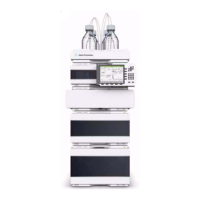Agilent 1200 Infinity Series DAD User Manual 73
Using the Module
4
Solvent Information
Solvent Information
Observe the following recommendations on the use of solvents.
• Follow recommendations for avoiding the growth of algae, see pump
manuals.
• Small particles can permanently block capillaries and valves. Therefore,
always filter solvents through 0.4 μm filters.
• Avoid or minimize the use of solvents that may corrode parts in the flow
path. Consider specifications for the pH range given for different materials
like flow cells, valve materials etc. and recommendations in subsequent
sections.
Solvent information for parts of the 1260 Infinity Bio-inert LC system
For the Agilent 1260 Infinity Bio-inert LC system, Agilent Technologies uses
highest quality materials (see “Bio-inert Materials” on page 17) in the flow
path (also referred to as wetted parts), which are widely accepted by life
scientists, as they are known for optimum inertness to biological samples, and
ensure best compatibility to common samples and solvents over a wide pH
range. Explicitly, the complete flow path is free from stainless steel and free
from other alloys containing metals such as iron, nickel, cobalt, chromium,
molybdenum or copper, which can interfere with biological samples. The flow
downstream of the sample introduction contains no metals whatsoever.
However, there are no materials that combine suitability for versatile HPLC
instrumentation (valves, capillaries, springs, pump heads, flow cells etc.) with
complete compatibility with all possible chemicals and application conditions.
This section recommends the preferred solvents. Chemicals that are known to
cause issues should be avoided, or exposure should be minimized, for
example, for short-term cleaning procedures. After potentially aggressive
chemicals have been used, the system should be flushed with compatible
standard HPLC solvents.

